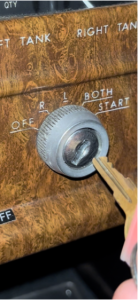The Charity
Aviation
Maritime
GA1317

Initial Report
I was asked to park the club training aircraft, a C152, in the hangar for the night and I needed to rotate the propellor by hand in order to attach the towbar to the nose gear leg. Before touching the propeller I checked the mag switch, (a key operated multi-position barrel switch) and saw the key removed. It didn’t look quite right however, and on closer inspection I could see that the ignition barrel switch was in the BOTH position, with the key removed, meaning the mags were no longer earthed, but LIVE. I inserted the key, which the barrel accepted, and rotated the switch to OFF. The fault was not immediately repeatable, in that I could not remove the key with the switch selected to BOTH. Observations were reported to the club. Lesson learnt: not to trust the key removed as a positive indication of mags off.
The flying club has investigated, has taken a written statement from all individuals involved, and has disseminated the information about the event to all club members as an immediate awareness measure. The switch in question has been investigated and the fault has been reproduced [see photograph]. As such, it is intended that the switch will be changed. The fault occurred when the key was inserted upside down, and there is anecdotal evidence that this has been seen with this type of switch in the past. I have subsequently filed an MOR, the switch has been replaced, and internal club reporting rules amended to capture events such as this.
Manufacturer Comment
Thank you for bringing this matter to our attention. A cursory review of our database for this type of issue did not find any other reports of operators being able to insert the key upside down. Our database is dependent on customers and operators reporting issues to us; however, unlike large aircraft they are not bound to report issues, so most do not, especially on the older out of production models. It was interesting that the issue could be repeated if the key was inserted upside down. One of our Affiliated Service Facilities was visited and a few checks made on several [Aircraft] that had the same ignition switch as the one in the report. (Based on the image provided). Attempting to insert the key upside down using the ignition key supplied with the switches and also some keys that had been locally cut as spares, we were unable to fit a key into a switch in the upside-down position. In a serviceable switch this would take an amount of force and determination on behalf of the operator to achieve and one would suspect that removal of the key would be equally difficult. Technicians at the Service Facility also stated that it was their practice after carrying out engine ground runs to stop the engine using the mixture control, then to try and remove the key with the magnetos selected to both, then the left and right positions, to ensure it is not possible to remove a properly inserted key in any position other than off. The Service Bulletin previously discussed may not be applicable to the part number of the ignition switch fitted to the aircraft in question but it does highlight the danger of a “live” ignition switch. The overall conclusion is that the ignition switch barrel has been worn allowing the key to be inserted upside down, or the key used was worn or not the correct key for the ignition switch.
CHIRP Comment
This is a great example of why there is a need to follow standard safety procedures, which, as individuals, we add to based on personal experience. It was a really good spot to notice the lock looked unusual, and excellent that further investigation was actioned. The reporter filed an MOR to the UK CAA, and CHIRP thought it prudent to inform the Manufacturer to widen knowledge of the possible dangers involved with this ‘motor car design’ from the last century. Ultimately, this incident had very serious safety implications and well done to the reporter for trusting their instincts to make sure that they verified the actual condition of the switch rather than just relying on the fact that the key was removed. The issue of worn keys and mag switches is not a new one, many older aircraft suffer from this problem but the reporter had done the right thing in raising the issue with the club concerned, and they had done the right thing in having the switch replaced. Although worn switches may well be common, they should not simply be accepted as such because dangerous situations like that reported could have serious consequences. The main lesson is to physically check the position of mag switches and not rely on the key being absent to assume the mag switch is off. Finally, the old adage of ‘always treat a propeller as live’ is still pertinent, and we commend the reporter for their rigorous approach to their checks.
Key Issues relating to this report
Dirty Dozen Human Factors
The following ‘Dirty Dozen’ Human Factors elements were a key part of the CHIRP discussions about this report and are intended to provide food for thought when considering aspects that might be pertinent in similar circumstances.
Awareness – inputs not assimilated or sought (magneto switch not at off when key removed)
Deviation – normalisation of divergence from formal procedures or taking short-cuts (removal of key without selecting magnetos to ‘off’)
This data type is not supported!